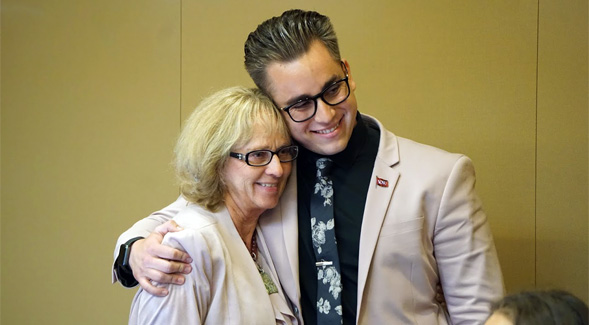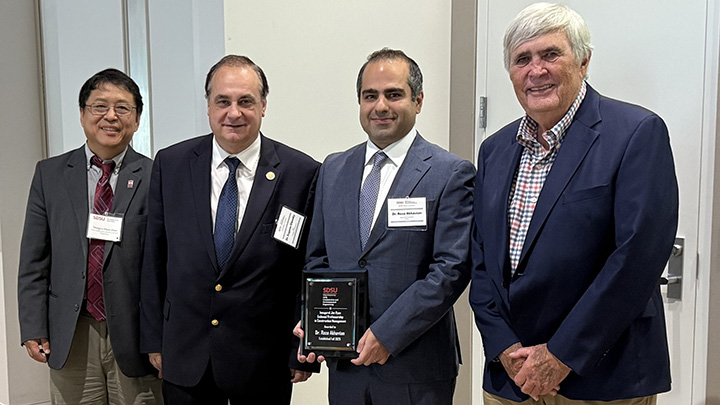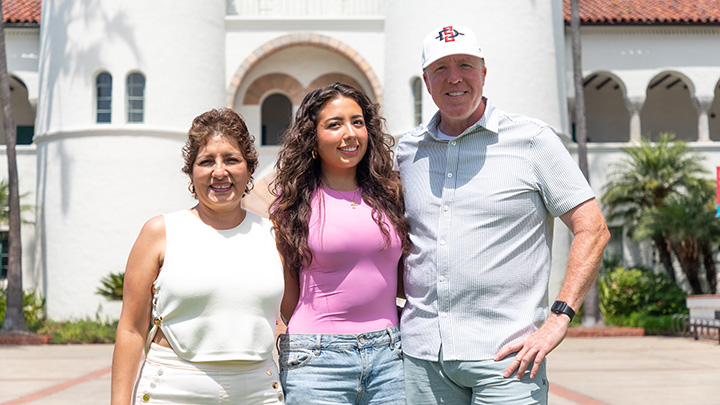Final Reflections from President Roush
The leader widely known as Sally looks back on her tenure as SDSU president.

On July 1, 2017, Sally Roush became president of San Diego State University. She was appointed to a one-year interim term by California State University (CSU) Chancellor Timothy P. White following the resignation of former president Elliot Hirshman. Roush wraps up her term at the end of this month as President-Designate Adela de la Torre begins her tenure at SDSU.
Having held several positions at the university and retiring in 2013 as a senior vice president, Roush then served as interim vice chancellor/chief financial officer for the CSU Office of the Chancellor in 2014. She drew on those experiences to lead the university through an extraordinary year of great opportunities and monumental challenges.
The full version of this interview appears in the June 2018 SDSU Alumni enewsletter.
Interviewer: A case can be made that this past academic year has been one of the most pivotal in the university’s history considering the opening of the EIS Complex, the search for a new president, the unveiling of the SDSU Mission Valley Plan, and the Aztec Identity discussion and decision. How much consideration did you give to these issues before accepting your interim role and what characteristics do you possess that equipped you to address such a wide range of momentous developments?
Roush: “I knew it would be a critical year and the most important thing that would happen would be to select a new president. And I knew that the Aztec Identity issue was out there. Keep in mind this was a year ago in April when the chancellor first called me.
Then I started hearing a little bit about the issues around the stadium lease and Mission Valley. It hadn’t translated into the Mission Valley Plan at that time. That’s really all I had in my head when I said yes (to the presidential appointment).
I can’t say exactly what characteristics I possess. It’s the way I live my life. Big or small issues, if something seems too hard, I break it down into smaller pieces and go ahead one step at a time.”
You have said you consider yourself a problem solver, so as president, what’s the biggest problem you solved?
“Getting a site plan for Mission Valley, I think, solves a perceived problem that we didn’t have a plan. Putting that together has been a big accomplishment.
Addressing the Aztec Identity issue I wouldn’t say has been solved, but we have addressed it again in a way that I hope will ensure that we stay true to the changes we said we want to make, which are not all that different from the changes we said we wanted to make in 2001. I think having a (new) governing authority chaired by the president of the university with a $200,000 budget for next year will keep things on track and we will hire a coordinator to keep attention focused on it at a level equivalent to the significance it deserves. We’re going to expand the Aztec Culture Education Committee to include some members of the local indigenous tribes and it will report to the governing authority. I think this will institutionalize it in a way that will make it persist over time.”
Why did you want to take on the controversial Aztec Identity issue?
“It wasn’t what I wanted or didn’t want to do. It was here. What I wanted to do was solve or resolve as many of these issues before a new president got here because it didn’t seem fair, if I had the opportunity to resolve them, to just sit back and wait until a new person got here and then say, ‘Here’s a bunch of big problems you have to solve.’”
How heavily did the Aztec Identity process and your having to make that decision weigh on you?
“Having to make the decision didn’t weigh on me. That’s something people should expect me to do. Trying to find the right way to frame it and characterize it so that there was a meaningful difference from what we’ve had in the past weighed heavily on me because people on either end of the spectrum feel so strongly about it and they have a right to have those strong feelings.
Even though I knew some, perhaps many, people would be unhappy (with the decision), I wanted them to have reason to believe that I cared about and considered their feelings and tried to address or communicate and truthfully say that I went about it caring about how everyone felt. And the emphasis I put on respect, I hope, will help make a decision that they may disagree with a little bit easier.
That message of respect wasn’t my own idea. It came out of the comments we received in response to the (Aztec Identity) survey. We left a space for comments and six thousand people wrote comments. Six thousand people is significant and their responses weren’t one or two words. They wrote about what they felt. Over and over again, ‘Be respectful. Be more respectful. We can be respectful. We respect. We want to respect.’ That message came from the people who responded and was amplified by the (Aztec Identity) task force.”
You used the word “hurt” in your statement to describe those who disagreed with your decision to retain SDSU’s Aztec Identity and the Aztec Warrior. How intentional or significant was that word choice?
“I know people were hurt. Saying their feelings were hurt sounds trite. They were hurt deeply either by the notion of the continuation of a human portraying a character that had meaning to them, or they were hurt by the notion of ‘political correctness’ that they felt was insipid and wasteful. It was one of the task force members who reminded me those extreme feelings come from a place of legitimate feelings. I am grateful to that person for calling me on that. I wanted to acknowledge that. Who am I to say that you shouldn’t feel the way you feel? That’s ridiculous.”
What was your highest high and your lowest low in your position the past year?
“Probably a couple of different things. Commencement was an incredible experience. It really was. Beating Stanford (in football) here was pretty cool. We had a student, Alejandro Arias, who was named the most outstanding student in the entire California State University System this year and I was at the Board of Trustees when he got that award and that was very powerful. There were many other wonderful experiences.
I’m not somebody who thinks about lows. I describe myself as no matter how hard a day I have had or how tired I am, I wake up the next morning cheerful for no good reason. It’s my personality. I owe that to my mom, I think. I don’t wallow in things. It would be hard for me to identify a low.”
You project a sense that any position you have held at the university has been more than just a job to you – that you have a personal stake in San Diego State. If that is accurate, what’s behind that feeling?
“It’s way more than a job because I have enjoyed and treasured the people so much over all the span of time. When I first came here, my daughters were five and seven and all my family was back in Colorado. Everyone at the university was warm and welcoming and friendly and caring and it was a feeling of instantaneous acceptance. I have felt that way ever since. I was grateful for that and have tried to make other people feel that way. It’s a self-reinforcing kind of a dynamic.”
You have tied up a lot of loose ends during your presidency. Where do you think the university stands as you close out your term?
“I think the university is at a wonderful moment in time. We finished that amazing capital campaign. My favorite part of the campaign is that of the $815 million we raised, $88 million was given by our own employees. It’s a remarkable fact that I think speaks well for the university. We are in a good financial position. We have uncertainties of the State of California, but we have been prudent managers of our budget over the years and it has served us well.
We have a new president who is everything we value. She’s a brilliant academic. She is a brilliant researcher. She is bilingual. She is committed to student success. She is committed to shared governance and has an open and welcoming communication style. I think we are at this moment where all of the great things that we are and the things that we value can come together and propel us forward.
I think we have the opportunity to continue our wonderful trajectory. I think how we go about doing that will be defined by what the new president brings in terms of strategic goals and things she wants to focus on, but I see that we can continue to be who we want to be and do it the way we’ve always done it, which is kind of uniquely our own: Accomplishing things in spite of all odds, we persevere and we get through it and we come out on the other side still standing tall and able to thrive. I think we will keep being who we are and who we have always been.”


